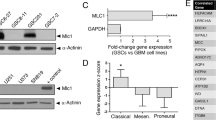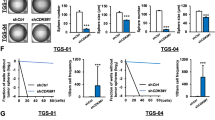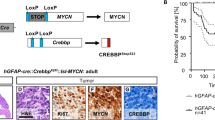Abstract
The development of malignant gliomas (astrocytomas) involves the accumulation of multiple genetic changes, including mutations in the p53 and retinoblastoma (Rb) cell cycle regulatory pathways. One Rb pathway alteration seen in high-grade astrocytomas is amplification of cyclin dependent kinase-4 (CDK4). To define the function of CDK4 amplification/overexpression in astrocytoma pathogenesis, we generated three transgenic mouse lines that overexpress human CDK4 (hCDK4) in astrocytes using the human glial fibrillary acidic protein (GFAP) promoter. GFAP-hCDK4 mice do not develop brain tumors, but exhibit a small increase in astrocyte number. Cultured astrocytes from these mice do not demonstrate a cell-autonomous growth advantage in vitro and lack properties of transformed cells. To determine whether cdk4 overexpression provides a cooperative growth advantage in vitro, CDK4-overexpressing C6 glioma cell lines were generated and found to exhibit increased cell growth. In addition, GFAP-hCDK4; p53+/− as well as p53+/−; Rb+/− mice exhibited increased numbers of astrocytes compared to GFAP-hCDK4, p53+/−, or Rb+/− mice in vivo. No cooperative effect was observed with GFAP-hCDK4; Rb+/− mice. These results support the hypothesis that cdk4 overexpression alone is not sufficient for astrocytoma formation, but can provide a cooperative growth advantage in concert with genetic alterations in the p53 pathway.
This is a preview of subscription content, access via your institution
Access options
Subscribe to this journal
Receive 50 print issues and online access
$259.00 per year
only $5.18 per issue
Buy this article
- Purchase on Springer Link
- Instant access to full article PDF
Prices may be subject to local taxes which are calculated during checkout







Similar content being viewed by others
References
Bajenaru ML, Donahoe J, Corral T, Reilly KM, Brophy S, Pellicer A, Gutmann DH . 2001 GLIA 33: 314–323
Bischoff FZ, Yim SO, Pathak S, Grant G, Siciliano MJ, Giovanella BC, Strong LC, Tainsky MA . 1990 Cancer Res. 50: 7979–7984
Bogler O, Huang H-JS, Cavenee WK . 1995 Cancer Res. 55: 2746–2751
Bogler O, Nagane M, Gillis J, Huang HJS, Cavanee WK . 1999 Cell Growth Differ. 10: 73–86
Bowman T, Symonds H, Gu L, Yin C, Oren M, Van Dyke T . 1996 Genes Dev. 10: 826–835
Brenner M, Kisseberth WC, Su Y, Bernard F, Messing A . 1994 J. Neurosci. 3: 1030–1037
Ding H, Lau N, Roncai L, Wu X, Shannon P, Nagy A, Guha A, Gutmann D . 2000 Neuro-Oncology 2: 259–
Ding H, Roncari L, Shannon P, MacMaster S, Wu X, Lau N, Karaskova J, Gutmann DH, Squire JA, Nagy A, Guha A . 2001 Cancer Res. 61: 3826–3836
Donehower LA, Harvey M, Slagle BL, McArthur MJ, Montgomery CAJ, Butel JS, Bradley A . 1992 Nature 356: 215–221
Ekstrand AJ, Sugawa N, James CD, Collins VP . 1992 Proc. Natl. Acad. Sci. USA 89: 4309–4313
Franklin K, Paxinos G . 1997 The mouse brain in stereotaxic coordinates New York: Academic Press
Guha A, Feldkamp MM, Lau N, Boss G, Pawson A . 1997 Oncogene 15: 2755–2765
Gutmann DH, Donahoe J, Brown T, James CD, Perry A . 2000 J. Neuropath. Exp. Neurol. 26: 361–367
Gutmann DH, Loehr A, Zhang Y, Kim J, Henkemeyer M, Cashen A . 1999 Oncogene 18: 4450–4459
Hegi ME, Klein MA, Ruedi D, Chene P, Hamou MF, Aguzzi A . 2000 Cancer Res. 60: 3019–3024
Hewett SJ, Corbett JA, McDaniel ML, Choi DW . 1993 Brain Res. 625: 337–341
Holland EC, Hively WP, Gallo V, Varmus HE . 1998 Genes Dev. 12: 3644–3649
Ichimura K, Bolin MB, Goike HM, Schmidt EE, Moshref A, Collins VP . 2000 Cancer Res. 60: 417–424
Jacks T, Fazeli A, Schmitt EM, Bronson RT, Goodell MA, Weinberg RA . 1992 Nature 359: 295–300
Jacks T, Shih TS, Schmitt EM, Bronson RT, Bernards A, Weinberg RA . 1994 Nature Genet. 7: 353–361
Kleihues P, Cavanee WK . 2000 World Health Organization Classification of Tumours: Tumours of the Nervous System Lyon: IARC Press
Lau N, Feldkamp MM, Roncari L, Loehr AH, Shannon P, Gutmann DH, Guha A . 2000 J. Neuropath Exp. Neurol. 59: 759–767
Li FP, Fraumeni Jr JF . 1969 J. Natl. Cancer Inst. 43: 1365–1373
Listernick R, Charrow J, Gutmann DH . 1999 Am. J. Med. Genet. 89: 38–44
Marino S, Vooijs M, van der Gulden H, Jonkers J, Berns A . 2000 Genes Dev. 14: 994–1004
Reifenberger G, Ichimura K, Reifenberger J, Elkahloun AG, Meltzer PS, Collins VP . 1996 Cancer Res. 56: 5141–5145
Reifenberger G, Reifenberger J, Ichimura K, Meltzer PS, Collins VP . 1994 Cancer Res. 54: 4299–4303
Reilly KM, Loisel DA, Bronson RT, McLaughlin ME, Jacks T . 2000 Nature Genet. 26: 109–113
Rollbrocker B, Waha A, Louis DN, Wiestler OD, von Deimling A . 1996 Acta. Neuropathol (Berl) 92: 70–74
Rose K, Goldberg MP, Choi DW . 1993 In Vitro Biological Systems. Tyson CA and Frazier JM (eds) New York: Academic Press pp 46–60
Schlegel J, Piontek G, Kersting M, Schuermann M, Kappler R, Scherthan H, Weghorst C, Buzard G, Mennel H . 1999 Pathobiology 67: 202–206
Scotto C, Deloulme JC, Rousseau D, Chambaz E, Baudier J . 1998 Mol. and Cell. Biol. 18: 4272–4281
Serrano M, Le H-W, Chin L, Cardon-Cardo C, Beach D, DePinho RA . 1996 Cell 85: 27–37
Symonds H, Krall L, Remington L, Saenz-Robles M, Lowe S, Jacks T, Van Dyke T . 1994 Cell 78: 703–711
Timiryasova TM, Chen B, Haghighat P, Fodor I . 1999 Int. J. Oncol. 14: 845–854
Ueki K, Ono Y, Henson JW, Efird JT, von Deimling A, Louis DN . 1996 Cancer Res. 56: 150–153
Wakabayashi T, Messing A, Brenner M . 1999 Biotechniques 26: 302–307
Wong AJ, Bigner SH, Bigner DD, Kinzler KW, Hamilton SR, Vogelstein B . 1987 Proc. Natl. Acad. Sci. USA 84: 6899–6903
Yahanda AM, Bruner JM, Donehower LA, Morrison RS . 1995 Mol. Cell. Biol. 15: 4249–4259
Yin D, Kondo S, Barnett GH, Morimura T, Takeuchi J . 1995 Neurosurgery 37: 758–763
Zhou L, Sun B, Zhang CL, Fine A, Chiu SY, Messing A . 1997 Dev. Biol. 187: 36–42
Acknowledgements
We gratefully appreciate the advice of Dr M Livia Bajenaru and the technical assistance of Ms Wen Li in our laboratory as well as Mia Nichols in The Washington University Neuroscience Transgenic Core. This work was supported by funding from The National Institutes of Health (NS41097 to DH Gutmann) and The American Cancer Society (RPG-00-231-01-CNE to DH Gutmann).
Author information
Authors and Affiliations
Corresponding author
Rights and permissions
About this article
Cite this article
Huang, Zy., Baldwin, R., Hedrick, N. et al. Astrocyte-specific expression of CDK4 is not sufficient for tumor formation, but cooperates with p53 heterozygosity to provide a growth advantage for astrocytes in vivo. Oncogene 21, 1325–1334 (2002). https://doi.org/10.1038/sj.onc.1205206
Received:
Revised:
Accepted:
Published:
Issue Date:
DOI: https://doi.org/10.1038/sj.onc.1205206
Keywords
This article is cited by
-
Comparative transcriptomics reveals similarities and differences between astrocytoma grades
BMC Cancer (2015)
-
PIKE-A is a proto-oncogene promoting cell growth, transformation and invasion
Oncogene (2007)
-
In vivo proliferation of differentiated pancreatic islet beta cells in transgenic mice expressing mutated cyclin-dependent kinase 4
Diabetologia (2004)



